

A young boy looks up at the Robert E. Lee Confederate statue in Charlotteville Virginia in 2019. In 2017, the statue was the focal point as two groups clashed over its possible removal. As the nation watched, one group of protesters showed up to protest the statue’s removal. A group of counter protesters also showed up, and as the two groups violently clashed, the day would end with three individuals dead. A man drove his car into a crowd of counter protesters killing 32-year-old Heather Heyer and injuring 19 others. Two police officers also died in a helicopter crash that day. The statue was removed in 2021. It was recently the center of the news once again in October of 2023 when it was melted down by an African American museum in Charlottesville after two groups tried trying to preserve that statue failed to gain ownership.
Make Comment/View Comments
Additional Credits
Video
Photographer Statement
Tee Otey utilizes photography as a powerful tool to tell stories. She creates art that examines a vast array of challenges in broad social, historical, and political contexts. She has used photography as a vehicle to highlight important stories about communities that are in the midst of transformation. Tee’s work focused on documenting the fights of communities as they attempt to do away with the status quo. As communities utilize protest as an agent of change, they are breaking with tradition and building something new. By capturing these moments, Tee has effectively used photography to create a visual record of the changing physical landscape of communities. Recently her work has focused on documenting the transformation of public spaces that housed Confederate statues in Virginia in the wake of George Floyd’s death. Floyd’s death instigated a sea change. During the social justice protests that followed, many protesters determined that they should have a say in what occupies the public space in their communities. Though protests occurred around the nation, Virginia’s protests occurred against the backdrop of the state’s massive Confederate statues. As protesters rallied for change, they set their sights on the monuments. In Richmond, Virginia, the former “Capital of the Confederacy”, where some residents have long extolled the virtues of the Confederacy, a perfect storm was brewing. A pandemic, public health lockdowns, and a viral video of a Minnesota man dying at the hands of the police all combined and resulted in a change of historic proportions for the city. <>
License
To license this work for editorial, creative, or other uses, click on the OZMO logo above.
This will take you to the Ozmo website retro toys where you can review the cost and license for the photographs in this exhibit.
You will need to create an account with both Amazon payments and with the Ozmo website as described on the Ozmo website.
Tags
Content loading...
Resources
Affiliated NGO
Contact Photographer
Stats
Confederate statues have been the topic of debate for decades. The conversation reemerged in 2017 during a rally in Charlottesville. The eyes of the nation focused on Virginia, one of the states with the largest number of Confederate statues in the U.S. Opposing groups violently clashed over the fate of a statue. Americans again sets their sights on Virginia in 2020 after the death of Minneapolis resident George Floyd at the hands of police. Protesters marched throughthe streets, their rallying cries calling for police reform. Confederate statues - symbols of heritage to some but overt symbols of racism to others - became the focal point for protesters. As protesters called for the removal of these statues in public spaces, Virginia’s physical landscape began to undergo a physical transformation. Protesters tried to remove massive statues, painted colorful messages on statues,and occupied the spaces around the monuments. These areas became spaces for residents to memorialize those who died after police encounters, to socialize, and to address community issues. After months of protests and court cases, the statues came down and their pedestals were dismantled.
Confederate statues have been the topic of debate for decades. The conversation reemerged in 2017 during a rally in Charlottesville. The eyes of the nation focused on Virginia, one of the states with the largest number of Confederate statues in the U.S. Opposing groups violently clashed over the fate of a statue. Americans again sets their sights on Virginia in 2020 after the death of Minneapolis resident George Floyd at the hands of police. Protesters marched throughthe streets, their rallying cries calling for police reform. Confederate statues - symbols of heritage to some but overt symbols of racism to others - became the focal point for protesters. As protesters called for the removal of these statues in public spaces, Virginia’s physical landscape began to undergo a physical transformation. Protesters tried to remove massive statues, painted colorful messages on statues,and occupied the spaces around the monuments. These areas became spaces for residents to memorialize those who died after police encounters, to socialize, and to address community issues. After months of protests and court cases, the statues came down and their pedestals were dismantled.
Tee Otey utilizes photography as a powerful tool to tell stories. She creates art that examines a vast array of challenges in broad social, historical, and political contexts. She has used photography as a vehicle to highlight important stories about communities that are in the midst of transformation. Tee’s work focused on documenting the fights of communities as they attempt to do away with the status quo. As communities utilize protest as an agent of change, they are breaking with tradition and building something new. By capturing these moments, Tee has effectively used photography to create a visual record of the changing physical landscape of communities. Recently her work has focused on documenting the transformation of public spaces that housed Confederate statues in Virginia in the wake of George Floyd’s death. Floyd’s death instigated a sea change. During the social justice protests that followed, many protesters determined that they should have a say in what occupies the public space in their communities. Though protests occurred around the nation, Virginia’s protests occurred against the backdrop of the state’s massive Confederate statues. As protesters rallied for change, they set their sights on the monuments. In Richmond, Virginia, the former “Capital of the Confederacy”, where some residents have long extolled the virtues of the Confederacy, a perfect storm was brewing. A pandemic, public health lockdowns, and a viral video of a Minnesota man dying at the hands of the police all combined and resulted in a change of historic proportions for the city.
Content loading...
Make Comment/View Comments


A young boy looks up at the Robert E. Lee Confederate statue in Charlotteville Virginia in 2019. In 2017, the statue was the focal point as two groups clashed over its possible removal. As the nation watched, one group of protesters showed up to protest the statue’s removal. A group of counter protesters also showed up, and as the two groups violently clashed, the day would end with three individuals dead. A man drove his car into a crowd of counter protesters killing 32-year-old Heather Heyer and injuring 19 others. Two police officers also died in a helicopter crash that day. The statue was removed in 2021. It was recently the center of the news once again in October of 2023 when it was melted down by an African American museum in Charlottesville after two groups tried trying to preserve that statue failed to gain ownership.
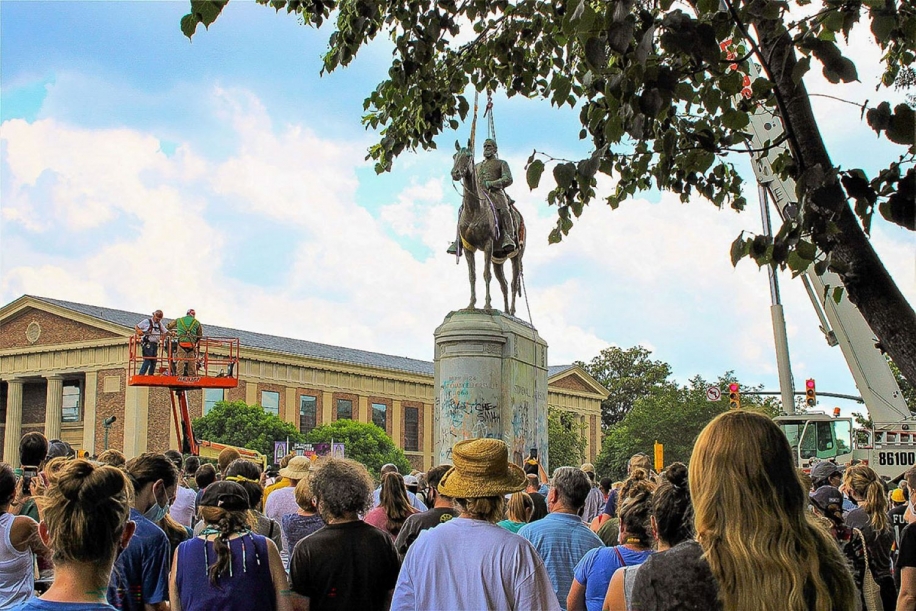
Crowds watch as crews prepare the statue of Thomas J. “Stonewall” Jackson for removal. As the afternoon passed, rain clouds moved into the area. Crowds later stood in the pouring rain cheering as lightning appeared across the sky and the statue of Jackson was removed from atop its pedestal and lowered to the ground. The monument sat on a tree lined boulevard aptly named "Monument Avenue". The avenue is lined with large affluent homes and until recently, it was punctuated with massive Confederate statues. After the death of George Floyd, the plinths of many of the monuments were painted with messages that called for police reform. Protesters even tried to topple the smaller statues. The bronze equestrian statue of Jackson, first unveiled in 1919, was removed in July of 2020. It was the first of Richmond's Confederate statues to be removed after Richmond's Mayor Levar Stoney utilized his emergency powers to have the statues removed. After the social justice protests following the death of George Floyd, the unified calls for justice and reform, and several court cases, all five of Monument Avenue’s Confederate statues, as well as other statues around the city, were removed and their pedestals were dismantled.
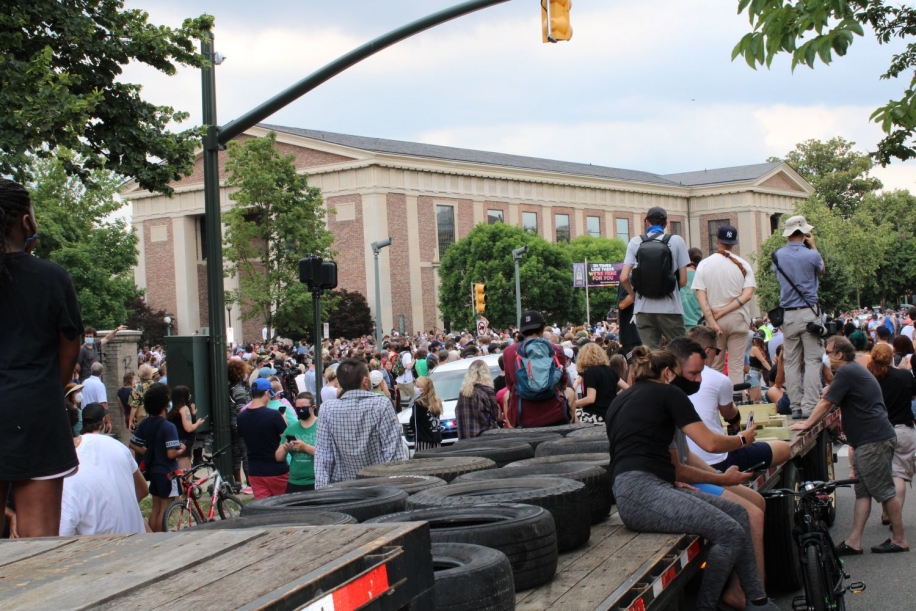
Crowds watch as crews prepare the statue of Thomas J. “Stonewall” Jackson for removal. As train clouds moved into the area crowds stood in the pouring rain cheering as lightning appeared across the sky and the statue of Jackson was removed from atop its pedestal and lowered to the ground. The monument sat on a tree lined boulevard aptly named "Monument Avenue". The avenue is lined with large affluent homes and until recently, it was punctuated with massive Confederate statues. After the death of Minneapolis resident George Floyd, the plinths of many of the monuments were painted with messages that called for police reform. Protesters even tried to topple a few of the smaller statues. The bronze equestrian statue of Jackson, first unveiled in 1919, was removed in July of 2020. It was the first of Richmond's Confederate statues to be removed after Richmond's Mayor Levar Stoney utilized his emergency powers to have the statues removed. After the social justice protests following the death of George Floyd, the unified calls for justice, and several court cases, all five of Monument Avenue’s Confederate statues, as well as other statues around the city, were removed and their pedestals were dismantled.
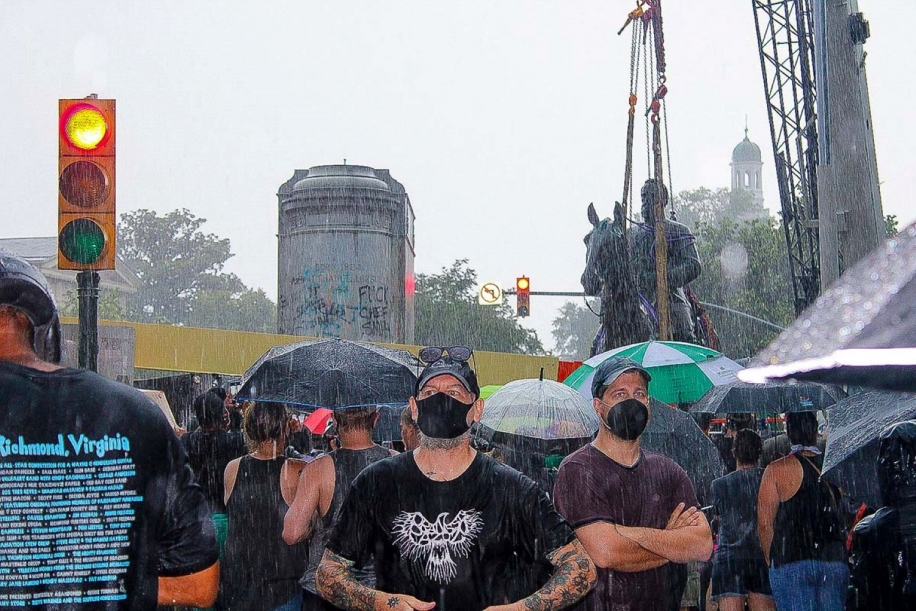
The statue of Thomas J. "Stonewall" Jackson sits on the ground as rain pours down. Crowds stood in the pouring rain cheering as lightning appeared across the sky and the statue of Jackson was removed from atop its pedestal and lowered to the ground. The monument sat on a tree lined boulevard aptly named "Monument Avenue". The avenue is lined with large affluent homes and until recently, it was punctuated with massive Confederate statues. After the death of Minneapolis resident George Floyd, protesters in the city took to the streets. The plinths of many of the monuments were painted with messages that called for police reform. Protesters even tried to topple a few of the smaller statues. The bronze equestrian statue of Jackson, first unveiled in 1919, was removed in July of 2020. It was the first of Richmond's Confederate statues to be removed after Richmond's Mayor Levar Stoney utilized his emergency powers to have the statues removed. After the social justice protests following Floyd’s death, the unified calls for justice, and several court cases, all five of Monument Avenue’s Confederate statues, as well as other statues around the city, were removed and their pedestals were dismantled.
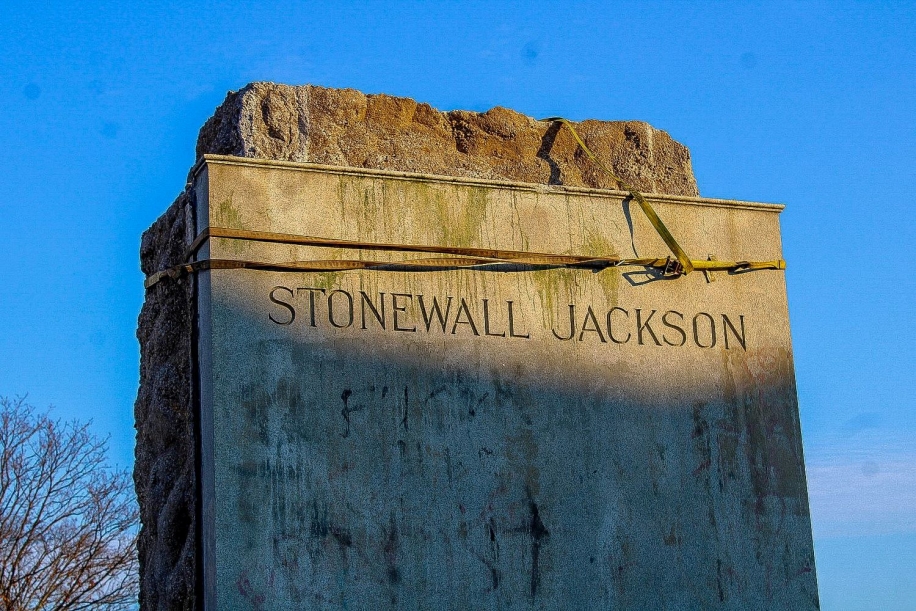
In 2022, a fragment of the Thomas J. “Stonewall” Jackson pedestal stood in the setting sun as crews dismantled the monument’s pedestal. Two years before, some of the same crew members prepared the statue for removal from its pedestal as rain clouds approached. Crowds stood in the pouring rain and cheered as lightning appeared across the sky and the statue was removed from atop its pedestal. The monument sat on a tree lined boulevard aptly named "Monument Avenue". The avenue is lined with large affluent homes and until recently, it was punctuated with massive Confederate statues. After the death of George Floyd, the plinths of many of the monuments were painted with messages that called for police reform by protesters. Protesters even tried to topple a few of the smaller statues. The bronze equestrian statue of Jackson, first unveiled in 1919, was removed in July of 2020. It was the first of Richmond's Confederate statues to be removed after Richmond's Mayor Levar Stoney utilized his emergency powers to have the statues removed. After the protests, the unified calls for justice, and several court cases, all of Monument Avenue’s Confederate statues were removed, and their pedestals were dismantled.
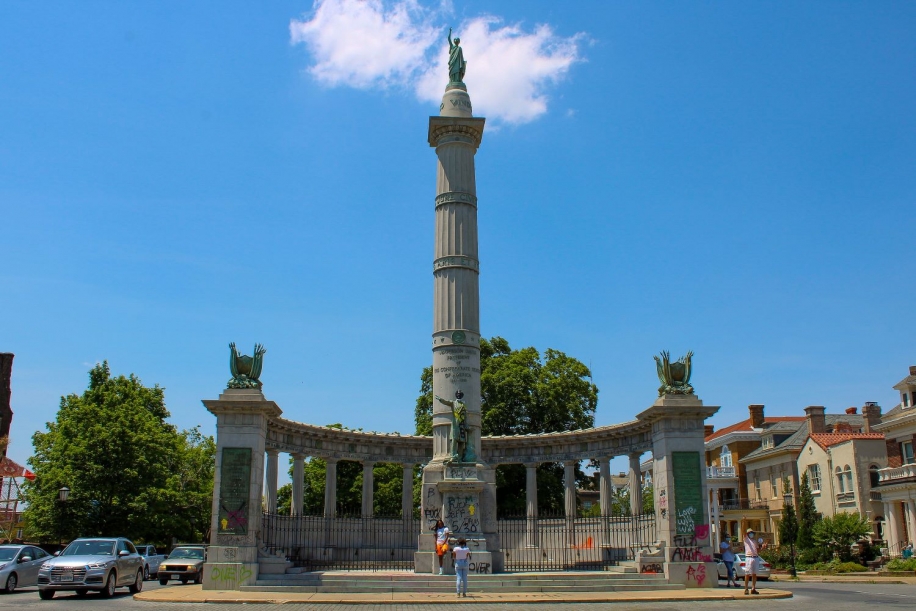
Individuals stop by to look at the Jefferson Davis Confederate Monument. The surface of the monument was painted with messages calling for reform and smeared with paint. Davis served as the president of the Confederate states during the Civil War. After the death of George Floyd, protesters in Richmond demanded that Confederate monuments be removed. The Davis monument was unveiled on June 3, 1907, the birthday of Davis. The monument consisted of a bronze statue of Davis surrounded by a colonnade of 13 columns that represented the Southern states. Behind the Davis statue was a tall Doric column that was topped by a bronze statue, Vindicatrix, which represented Southern womanhood. On the night of June 10, 2020, protesters used rope to topple the Davis statue that sat atop a pedestal in the middle of the monument's elaborate structure. The dented statue, smeared with neon-pink paint, became the centerpiece of an exhibit in a nearby museum. Richmond’s mayor utilized his emergency powers to remove Confederate statues around the city. Though most statues were removed in 2020, it took almost two years before crews dismantled the ornate pedestals that the statues had occupied. The pedestals often took weeks to remove.
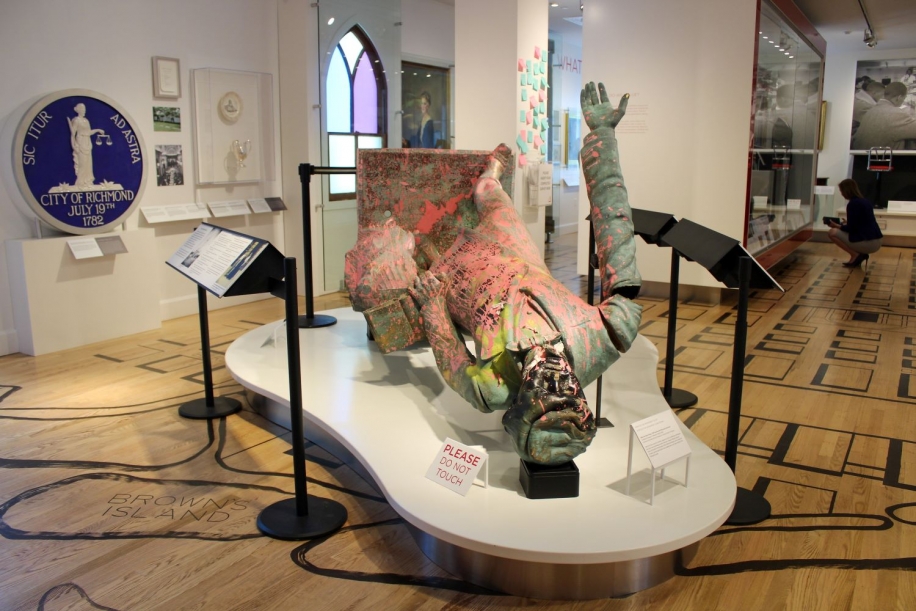
The surface of the Jefferson Davis Confederate Monument was painted with messages calling for reform and smeared with paint. Davis served as the president of the Confederate states during the Civil War. After the death of George Floyd, protesters in Richmond demanded that Confederate monuments be removed. The Davis monument was unveiled on June 3, 1907, the birthday of Davis. The monument consisted of a bronze statue of Davis surrounded by a colonnade of 13 columns that represented the Southern states. Behind the Davis statue was a tall Doric column that was topped by a bronze statue, Vindicatrix, which represented Southern womanhood. On the night of June 10, 2020, protesters used rope to topple the Davis statue that sat atop a pedestal in the middle of the monument's elaborate structure. The statue, smeared with neon-pink paint and dented, became the centerpiece of an exhibit in a nearby museum. Richmond’s mayor utilized his emergency powers to remove Confederate statues around the city. Though most statues were removed in 2020, it took almost two years before crews began dismantling the ornate pedestals that the statues had occupied. The pedestals often took weeks to remove.
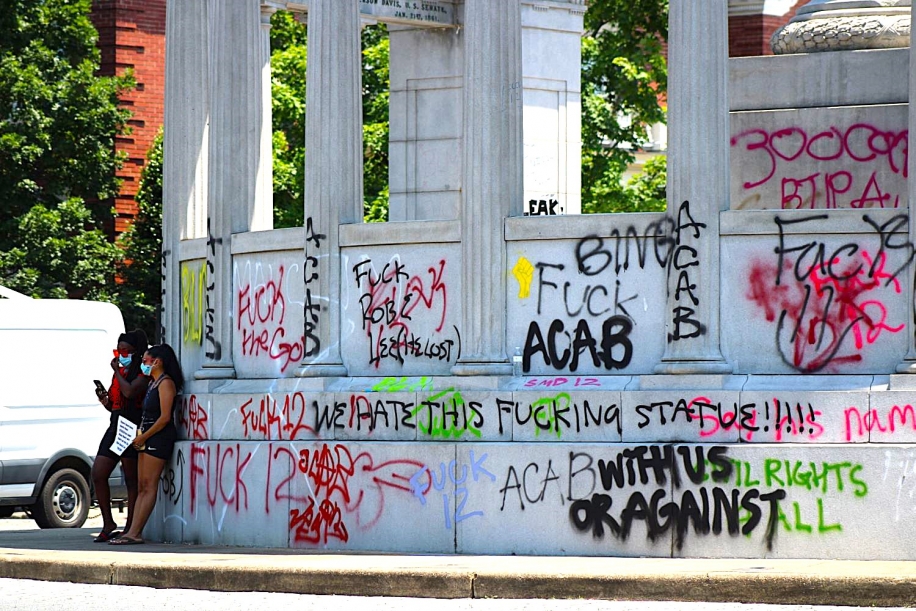
Individuals stop by to look at the Jefferson Davis Confederate Monument. The surface of the monument was painted with messages calling for reform and smeared with paint. Davis served as the president of the Confederate states during the Civil War. After the death of George Floyd, protesters in Richmond demanded that Confederate monuments be removed. The Davis monument was unveiled on June 3, 1907, the birthday of Davis. The monument consisted of a bronze statue of Davis surrounded by a colonnade of 13 columns that represented the Southern states. Behind the Davis statue was a tall Doric column that was topped by a bronze statue, Vindicatrix, which represented Southern womanhood. On the night of June 10, 2020, protesters used rope to topple the Davis statue that sat atop a pedestal in the middle of the monument's elaborate structure. The dented statue, smeared with neon-pink paint, became the centerpiece of an exhibit in a nearby museum. Richmond’s mayor utilized his emergency powers to remove Confederate statues around the city. Though most statues were removed in 2020, it took almost two years before crews dismantled the ornate pedestals that the statues had occupied. The pedestals often took weeks to remove.
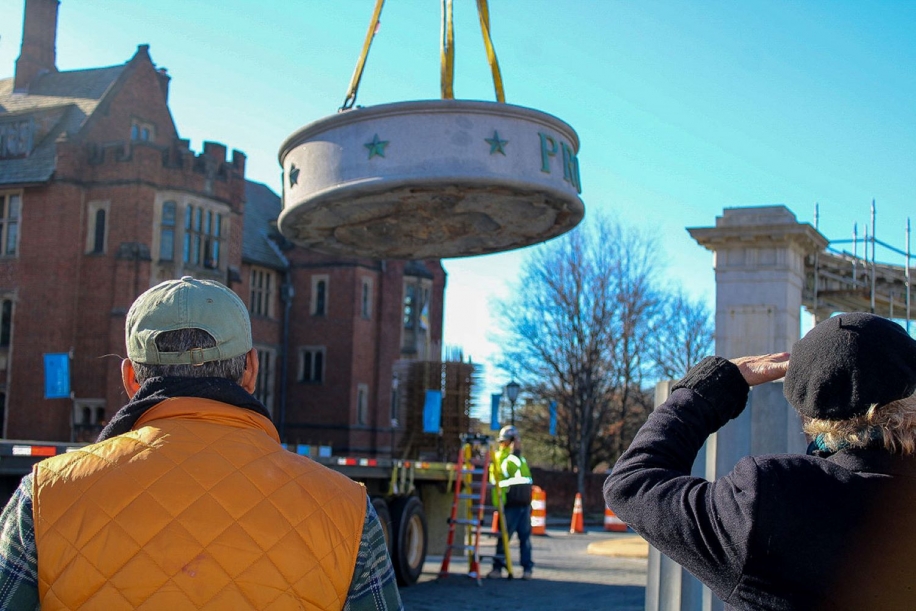
Crowds watch as the pedestal for the Jefferson Davis Confederate Monument was dismantled. Davis served as the president of the Confederate states during the Civil War. The monument was one of five Confederate monuments that sat on a treelined boulevard aptly named "Monument Avenue". After the death of George Floyd, protesters in Richmond demanded that these structures be removed. The monument was unveiled on June 3, 1907, the birthday of Davis. The monument consisted of a bronze statue of Davis that was surrounded by a colonnade of 13 columns that represented the Southern states. Behind the statue of Davis was a tall Doric column that was topped by a bronze statue, Vindicatrix, which represented Southern womanhood. On the night of June 10, 2020, protesters used rope to topple the statue of Davis that sat atop a pedestal in the middle of the monument's elaborate structure. The dented statue of Davis, smeared with neon-pink paint, became the centerpiece of an exhibit in a nearby museum. The city's mayor utilized his emergency powers to remove Confederate statues. Though most statues were removed in 2020, it took almost two years before crews dismantled the monument. The pedestals took weeks to remove.
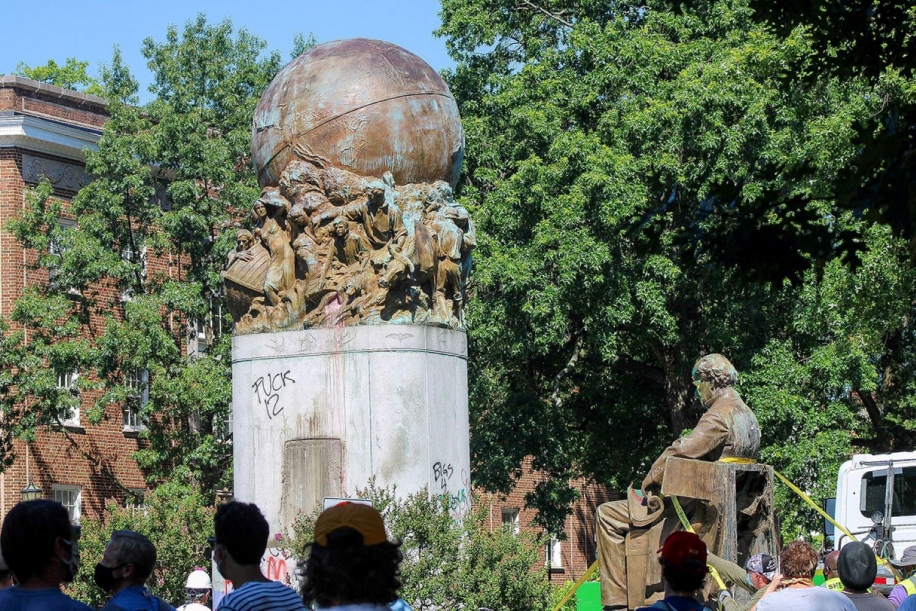
Crews work quickly to remove the statue of Matthew Fontaine Maury. The monument sat on a tree lined boulevard aptly named "Monument Avenue". The avenue is lined with large affluent homes and until recently, it was punctuated with massive Confederate statues. After the death of Minneapolis resident George Floyd, protesters in the city took to the streets. Marches were organized and some protesters turned their attention to the Confederate monuments in the city. The plinths of many of the monuments, including the Maury Monument, were painted with messages that called for police reform. Protesters even tried to topple a few of the smaller statues. The statue of Maury commemorated his Confederate naval service. First unveiled in 1929, the statue was removed in July of 2020. It was the first of Richmond's Confederate statues to be removed after Richmond's Mayor Levar Stoney utilized his emergency powers to have the statues removed. After the social justice protests following the death of George Floyd, the unified calls for justice and reform, and several court cases, all five of Monument Avenue’s Confederate statues, as well as other statues around the city, were removed and their pedestals were dismantled.
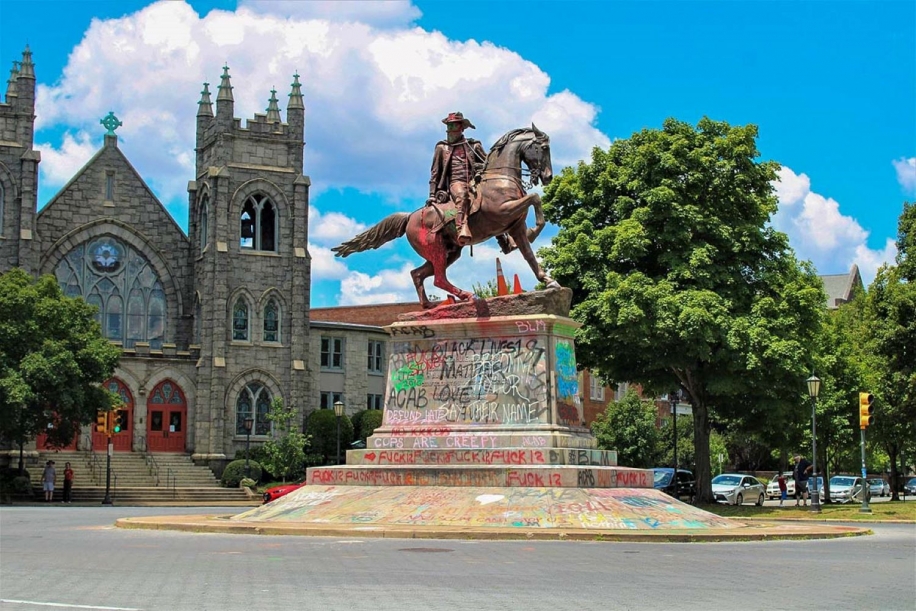
The James Ewell Brown “J.E.B.” Stuart Confederate statue was painted in brightly covered protest messages in 2020. After the death of Minneapolis resident George Floyd, protesters in the city took to the streets. Marches were organized and some protesters turned their attention to the Confederate monuments in the city, demanding that these symbols be removed. The plinths of many of the monuments, including the Stuart Confederate Monument, were tagged with messages that called for police reform. The monument, which was unveiled in 1907, sat on a tree lined boulevard aptly named "Monument Avenue" until it was removed in July of 2020. The avenue is lined with large affluent homes and until recently, it was punctuated with 5 massive Confederate statues. After the social justice protests, the unified calls for justice and reform, and several court cases, all 5 statues, as well as other statues around the city, were removed and their pedestals were dismantled.
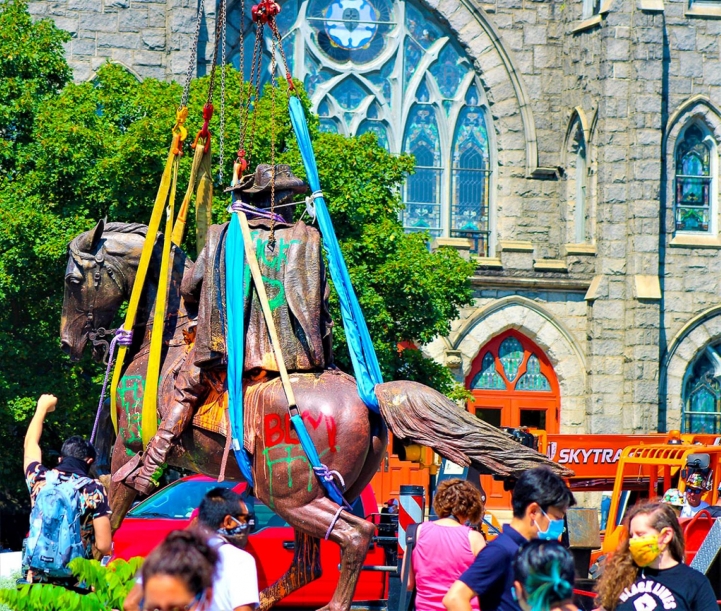
A young man raises his fist as the statue of James Ewell Brown “J.E.B.” Stuart touches down on the ground. After the death of Minneapolis resident George Floyd, protesters in the city took to the streets. Marches were organized and some protesters turned their attention to the Confederate monuments in the city, demanding that these symbols be removed. The plinths of many of the monuments, including the Stuart Confederate Monument, were painted with messages that called for police reform. The monument, which was unveiled in 1907, sat on a tree lined boulevard aptly named "Monument Avenue" until it was removed in July of 2020. The avenue is lined with large affluent homes and until recently, it was punctuated with 5 massive Confederate statues. After the social justice protests, the unified calls for justice and reform, and several court cases, all 5 statues, as well as other statues around the city, were removed and their pedestals were dismantled.
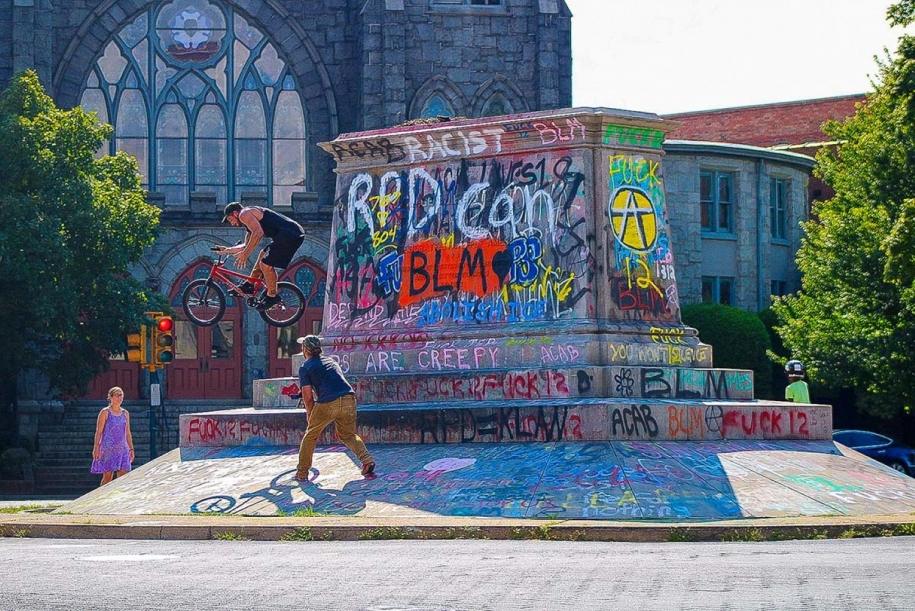
A biker performs tricks off the side of an empty pedestal that once held the James Ewell Brown “J.E.B.” Stuart Confederate statue. The empty pedestal remained until 2022 when it was dismantled. During that time, the surface of the pedestal was often covered in different messages that reflected the current political climate. Messages about police reform, voting, and other topics appeared before they were painted over by residents. Once the paint dried, individuals would return and paint more brightly covered messages. After the death of Minneapolis resident George Floyd, protesters turned their attention to the Confederate monuments in the city, demanding that these symbols be removed. The plinths of many of the monuments were painted with messages that called for police reform. The monument, which was unveiled in 1907, sat on a tree lined boulevard aptly named "Monument Avenue" until it was removed in July of 2020. The avenue is lined with large affluent homes and until recently, it was punctuated with 5 massive Confederate statues. After the social justice protests, the unified calls for justice, and several court cases, all 5 statues, as well as other statues around the city, were removed and their pedestals were dismantled.
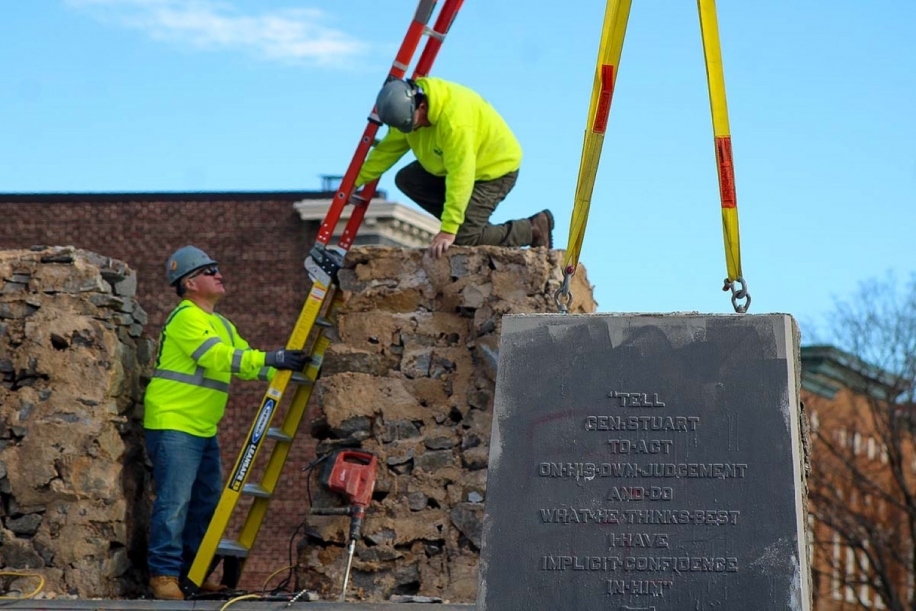
Crews work to dismantle the pedestal that once held the James Ewell Brown “J.E.B.” Stuart Confederate statue. The monument was painted in brightly covered protest messages in 2020. After the death of Minneapolis resident George Floyd, protesters in the city took to the streets. Marches were organized and some protesters turned their attention to the Confederate monuments in the city, demanding that these symbols be removed. The plinths of many of the monuments, including the Stuart Confederate Monument, were tagged with messages that called for police reform. The monument sat on a tree lined boulevard aptly named "Monument Avenue". The avenue is lined with large affluent homes and until recently, it was punctuated with 5 massive Confederate statues. After the social justice protests, the unified calls for justice and reform, and several court cases, all 5 statues, as well as other statues around the city, were removed and their pedestals were dismantled.
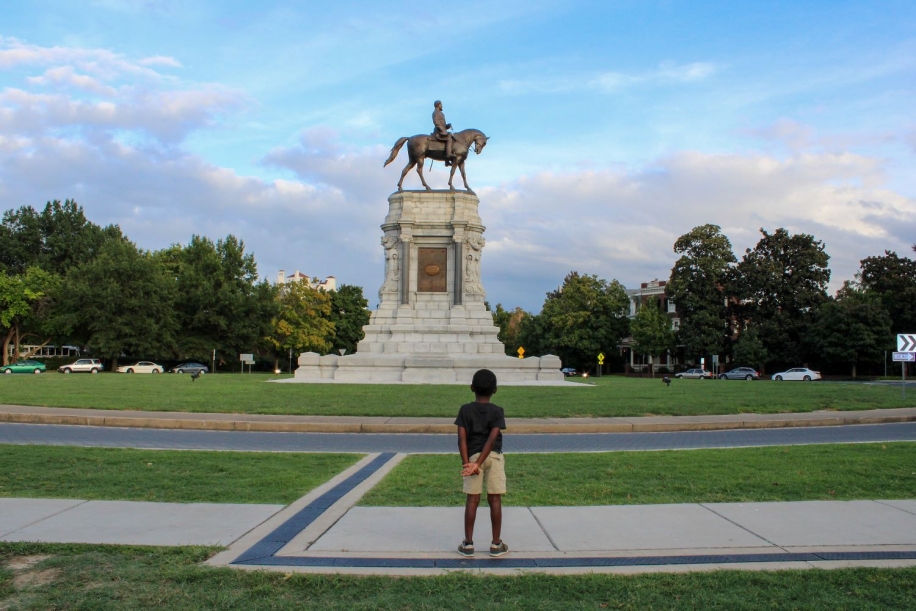
A young boy looks on at the Robert E. Lee Confederate Statue in Richmond, Virginia in 2019. Just a few months later, social justice protests would erupt around the world after the death of Minneapolis George Floyd. In Richmond, Virginia these protests would center around the presence of the presence of the city’s numerous Confederate monuments. Installed in 1890, the Lee statue that sat atop the massive pedestal was removed on September 8, 2021, after months of protests and court battles. The monument sat on a tree lined boulevard aptly named "Monument Avenue". The avenue is lined with large affluent homes and until recently, it was punctuated with 5 massive Confederate statues. After the social justice protests, the unified calls for justice and reform, and several court cases, all 5 statues, as well as many other Confederate statues in other parts of the city, were removed and their pedestals were dismantled.
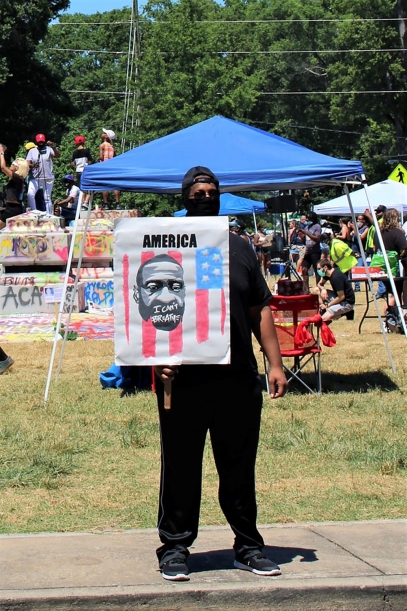
A protester raises a sign with a picture of Minneapolis resident George Floyd to call for police reform. After Floyd’s death, the plinth of the Robert E. Lee Confederate monument was painted with colorful messages that called for justice and police reform. Community members placed small signs that featured photographs of different individuals around the entire base of the plinth. These signs also included details about each of the encounters. During the protests, thousands of individuals visited the monuments and read these signs. During this same period, the space surrounding the monument was unofficially renamed "Marcus-David Peters Circle" - in memory of a young Richmond teacher who was killed by police while experiencing a mental health crisis. Professional signage was even installed by protesters featuring this new name. The space surrounding the statue became a focal point and gathering place for protesters. It also served as a space for community events including voter drives, music and dance recitals, and meeting spaces to devise solutions for issues like police brutality and problematic housing practices. Installed in 1890, the Lee statue that sat atop the massive pedestal was removed on September 8, 2021, after months of protests and court battles.
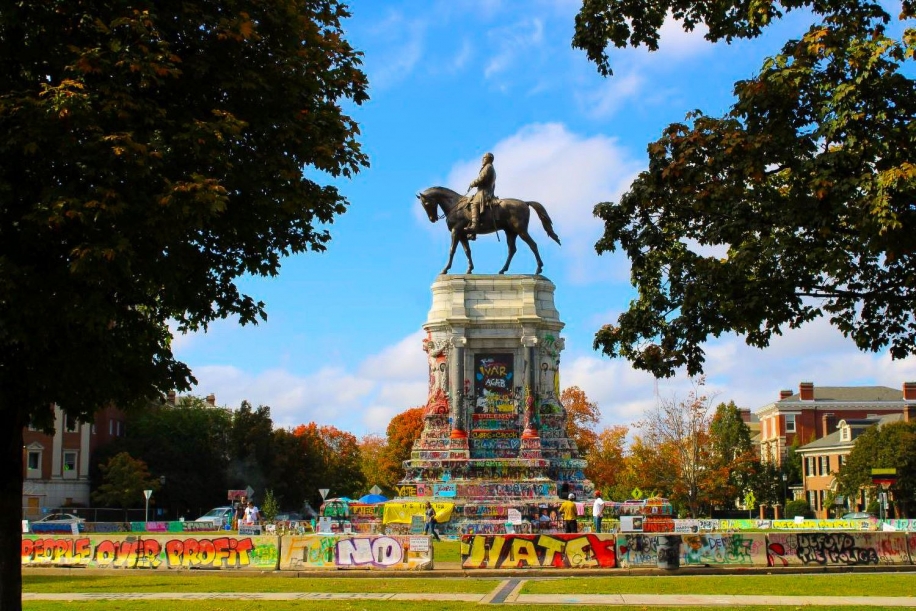
After the death of Minneapolis resident George Floyd, the plinth of the Robert E. Lee Confederate Monument was painted with brightly colored messages that called for police reform. City residents transformed the canvas of the monument into a work of protest art. The monument was even named as one of the most influential forms of American protest art since World War II by New York Times Magazine. Sometimes residents who did not agree with the paint showed up at night and painted over all of the protest messages with a solid color or they tried to wash the paint away with chemicals. Those who supported the protests simply returned hours later and repainted the surface of the pedestal. This cycle continued for months, and the result was an everchanging canvas with layers upon layers of painted messages as opposing groups tried to claim the monument and the space surrounding it. The monument itself was transformed into a police reform memorial. Community members placed small signs that featured a photograph of different individuals who died after encounters with the police around the entire base of the plinth. Thousands of visitors stopped by to read these signs.
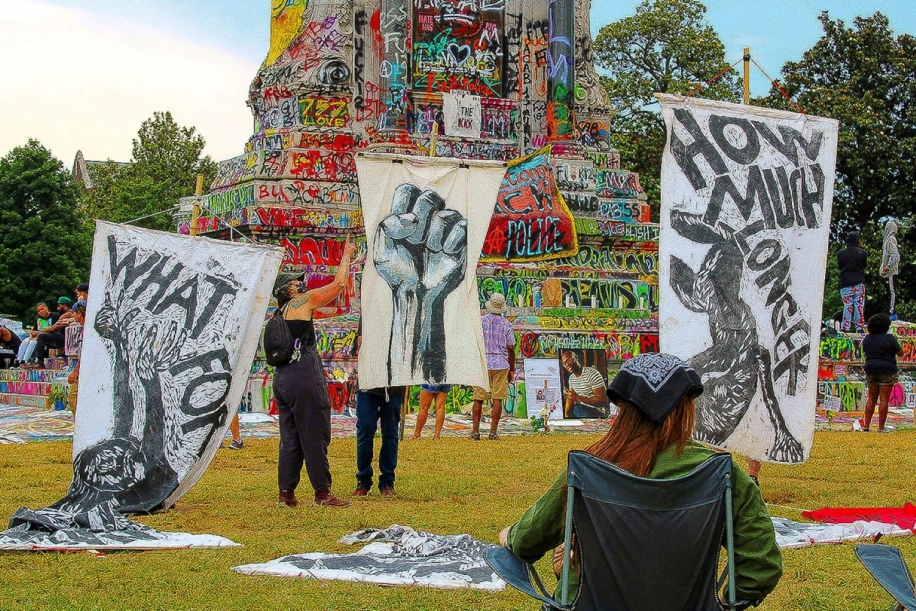
Protesters raise signs in an effort to call for police reform after the death of Minneapolis resident George Floyd. After Floyd’s death, the plinth of the Robert E. Lee Confederate monument was painted with colorful messages that called for justice and police reform. Community members placed small signs that featured photographs of different individuals around the entire base of the plinth. These signs also included details about each of the encounters. During the protests, thousands of individuals visited the monuments and read these signs. During this same period, the space surrounding the monument was unofficially renamed "Marcus-David Peters Circle" - in memory of a young Richmond teacher who was killed by police while experiencing a mental health crisis. Professional signage was even installed by protesters featuring this new name. The space surrounding the statue became a focal point and gathering place for protesters. It also served as a space for community events including voter drives, music and dance recitals, and meeting spaces to devise solutions for issues like police brutality and problematic housing practices. Installed in 1890, the Lee statue that sat atop the massive pedestal was removed on September 8, 2021, after months of protests and court battles.
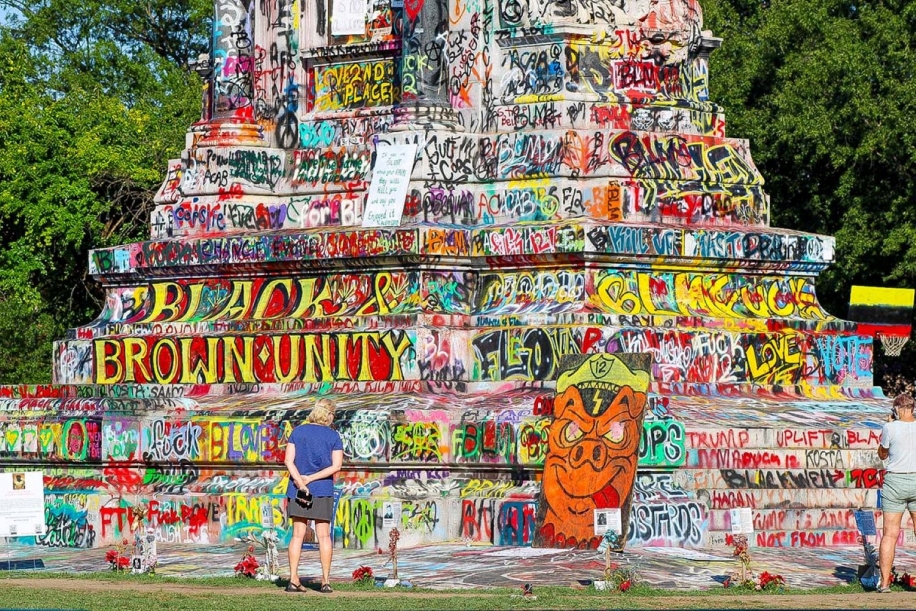
After the death of Minneapolis resident George Floyd, the plinth of the Robert E. Lee Confederate Monument was painted with brightly colored messages that called for police reform. City residents transformed the canvas of the monument into a work of protest art. The monument was even named as one of the most influential forms of American protest art since World War II by New York Times Magazine. Sometimes residents who did not agree with the paint showed up at night and painted over all of the protest messages with a solid color or they tried to wash the paint away with chemicals. Those who supported the protests simply returned hours later and repainted the surface of the pedestal. This cycle continued for months, and the result was an everchanging canvas with layers upon layers of painted messages as opposing groups tried to claim the monument and the space surrounding it. The monument itself was transformed into a police reform memorial. Community members placed small signs that featured a photograph of different individuals who died after encounters with the police around the entire base of the plinth. Thousands of visitors stopped by to read these signs.
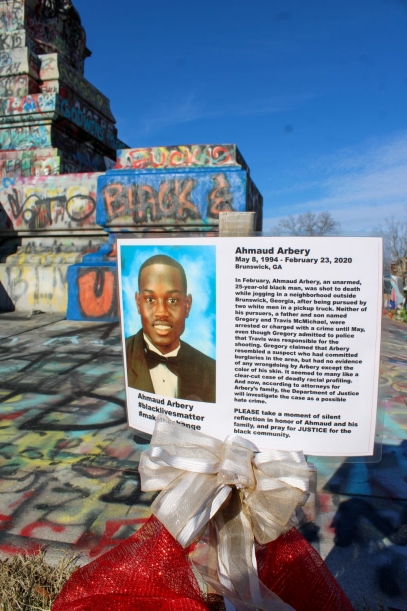
A photograph of Ahmaud Arbery was one of several that surrounded the base of the Robert E. Lee Confederate Monument. Arbery was a 25-year-old Black man, who was murdered during a racially motivated hate crime while jogging in a neighborhood in Georgia in 2020. After the death of Minneapolis resident George Floyd just a few months later, the plinth of the massive monument was painted with colorful protest messages that called for police reform. Community members placed numerous small signs that featured a photograph of different individuals (e.g., George Floyd, Breonna Taylor, Tamir Rice, Amadou Diallo, etc.) who died after encounters with the police around the entire base of the plinth and the space surrounding the grass at the base of the monument. The signs included details about each of these encounters. During the protests, the space surrounding the monument was unofficially renamed "Marcus-David Peters Circle" in memory of a young Richmond teacher who was killed by police while experiencing a mental health crisis.

Visitors look at signs that feature stories about individuals who died after encounters with the police. After the death of Minneapolis resident George Floyd just a few months later, the plinth of the massive monument was painted with colorful protest messages that called for police reform. Community members placed small signs that featured a photograph of different individuals (e.g., George Floyd, Breonna Taylor, Tamir Rice, Amadou Diallo, etc.) who died after encounters with the police around the entire base of the plinth. The signs included details about each of these encounters. During the protests, the space surrounding the monument was unofficially renamed "Marcus-David Peters Circle" in memory of a young Richmond teacher who was killed by police while experiencing a mental health crisis.
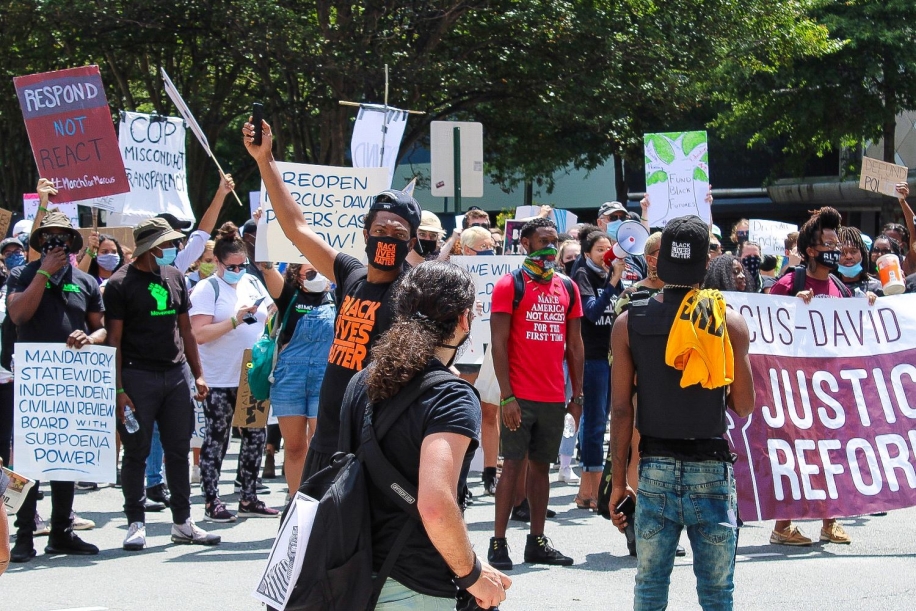
Protesters calling for police reform march through downtown Richmond, Virginia. The protesters marched in support of so many who have been killed at the hands of police including George Floyd and Richmond resident Marcus-David Peters. During the protests, the space surrounding the monument was unofficially renamed "Marcus-David Peters Circle" in memory of a young Richmond teacher who was killed by police while experiencing a mental health crisis. Protesters distributed a list of demands to the Mayor and Richmond's City Council. Demands on the list included: the creation of a civilian review board to discuss community issues (including policing practices), community meetings for residents’ concerns, the implementation of a “Marcus Alert” system (in honor of Peters), the removal of Confederate monuments, and the release of those arrested and jailed during the social justice protests following the death of George Floyd. Protesters were able to get the city to agree to several of the demands on the list including the implementation of the Alert system which enhances services for people experiencing a crisis related to mental health, substance use, or a developmental disability. The Alert creates coordination between 911 and crisis call centers and establishes a specialized behavioral health response.

"Liberated By The People" - After the death of Minneapolis resident George Floyd, the plinth of the massive monument was painted with colorful protest messages that called for police reform. Community members placed small signs that featured a photograph of different individuals who died after encounters with the police around the entire base of the plinth. The signs also included details about each of the encounters. During the protests, the space surrounding the monument was unofficially renamed "Marcus-David Peters Circle" - in memory of a young Richmond teacher who was killed by police while experiencing a mental health crisis. Professional signage featuring the new name was even installed in the circle as the space was reclaimed. The space surrounding the statue became a gathering place for protesters. It served as a space for community events including voter drives, music and dance recitals, and meeting spaces to devise solutions for community issues. A community garden was even planted with free vegetable for any individuals who need them. On several occasions, a sign featuring the Marcus-David Peters name was removed overnight by those who opposed the actions of protesters. Within a few days, another professionally made sign would appear in its place.
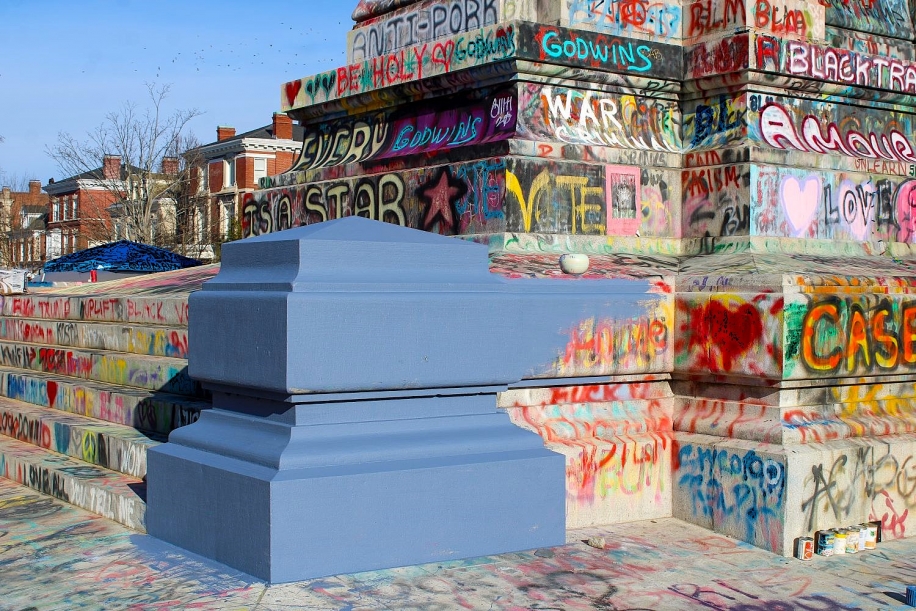
A section of the base of the Robert E. Lee Confederate Monument was painted with gray paint. After the death of Minneapolis resident George Floyd, the plinth of the massive monument was painted with colorful protest messages that called for police reform. Some residents who opposed the actions of protesters occasionally visited the statue overnight and attempted to wash the messages away or paint over them with a solid color. Protesters would quickly show up to the monument and begin the task of repainting brightly colored messages. Community members placed small signs that featured a photograph of different individuals who died after encounters with the police around the entire base of the plinth. The signs included details about each of these encounters. The space surrounding the monument was unofficially renamed "Marcus-David Peters Circle" in memory of a young Richmond teacher who was killed by police while experiencing a mental health crisis. Professional signage featuring the name was even installed in the circle as protesters reclaimed the space. On several occasions, a sign featuring the Marcus-David Peters name was removed overnight by those who opposed the actions of protesters. Within days, another professionally made sign would appear in its place.
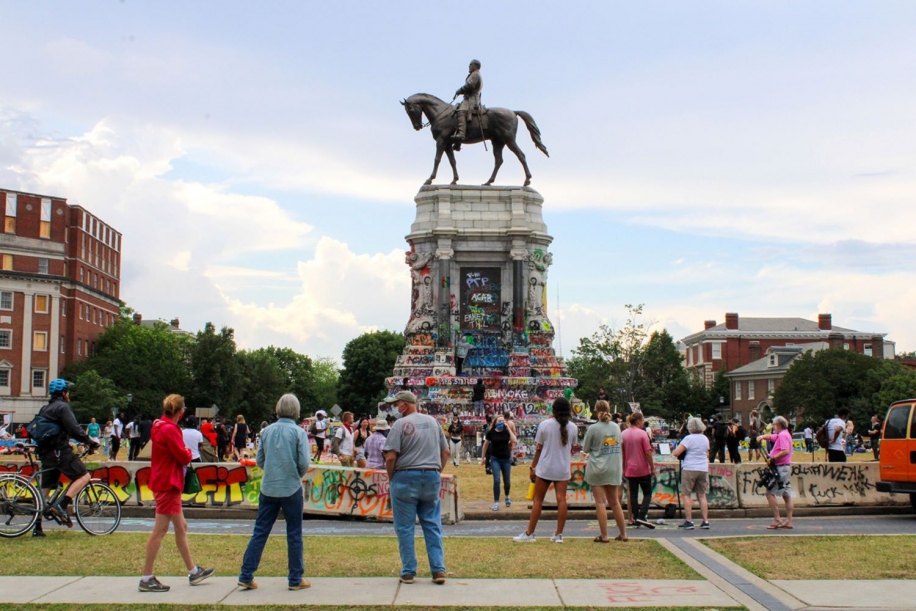
Protesters calling for justice gather in the large space at the base of the Robert E. Lee Confederate Monument. After the death of Minneapolis resident George Floyd, large numbers of individuals (often numbering in the hundreds at one time) would regularly gather in this space. The plinth of the monument was painted with brightly colorful messages that called for police reform. Community members placed small signs that featured photographs of different individuals around the entire base of the plinth. These signs also included details about each of the encounters. During this protest period, thousands of individuals visited the monuments and read these signs. Some supported the protests. while others did not. During this same period, the space surrounding the monument was unofficially renamed "Marcus-David Peters Circle" - in memory of a young Richmond teacher who was killed by police while experiencing a mental health crisis. Professional signage was even installed by protesters featuring this new name. The space surrounding the statue became a focal point and gathering place for protesters. It served as a space for community events including voter drives, music and dance recitals, and meeting spaces to devise solutions for issues like police brutality and problematic housing practices.
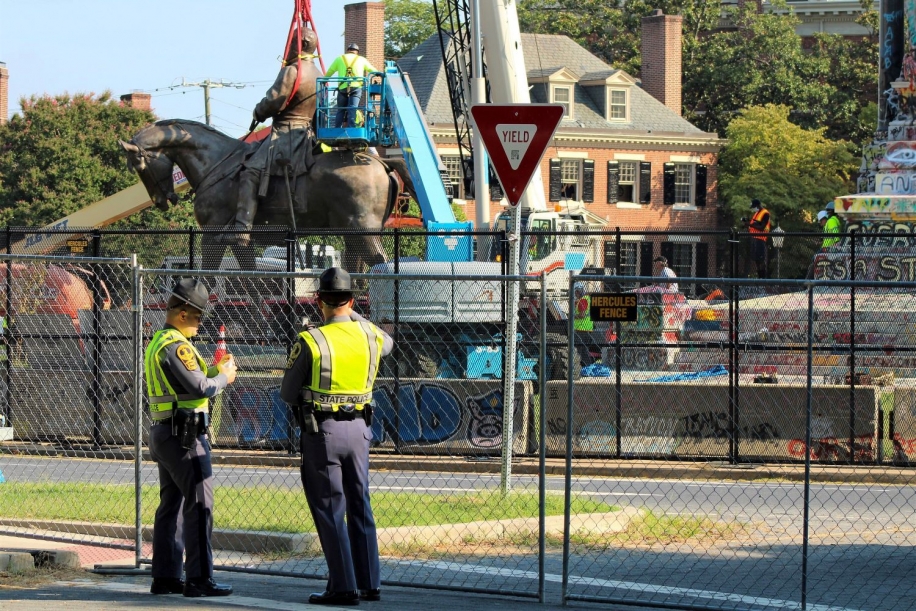
Two state police officers help to provide security as the Robert E. Lee Confederate statue was removed from atop its pedestal. As crowds cheered, large numbers of police units from all around Virginia were brought in and stationed in the areas immediately surrounding the statue and in neighborhoods close to the area to provide security while the statue was removed. Installed in 1890, the statue that sat atop a massive pedestal was removed on September 8, 2021. Crowds of onlookers applauded as the 12 ton, 61-foot-tall statue was lowered to the ground. The statue of Lee sitting astride his horse was so large that it had to be cut in half before it could be transported away from the site. After the death of Minneapolis resident George Floyd, protesters took to the streets and turned their attention to the Confederate monuments in the city, demanding that these statues be removed. The plinths of many monuments were painted with brightly colored messages that called for police reform. After the protests, the unified calls for justice, and several court cases, all of Monument Avenue’s Confederate statues, as well as other statues around the city, were removed and their pedestals were dismantled.
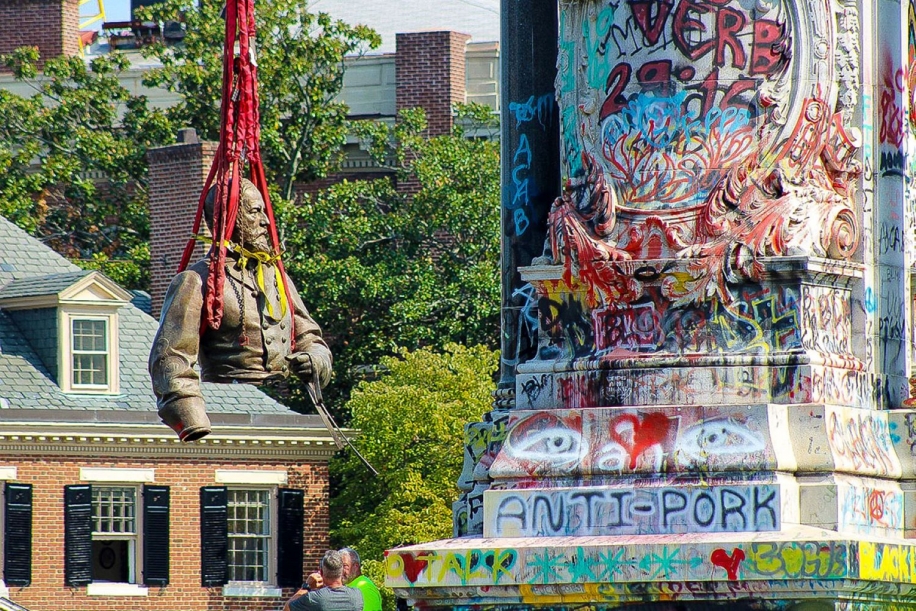
Two state police officers help to provide security as the Robert E. Lee Confederate statue was removed from atop its pedestal. As crowds cheered, large numbers of police units from all around Virginia were brought in and stationed in the areas immediately surrounding the statue and in neighborhoods close to the area to provide security while the statue was removed. Installed in 1890, the statue that sat atop a massive pedestal was removed on September 8, 2021. Crowds of onlookers applauded as the 12 ton, 61-foot-tall statue was lowered to the ground. The statue of Lee sitting astride his horse was so large that it had to be cut in half before it could be transported away from the site. After the death of Minneapolis resident George Floyd, protesters took to the streets and turned their attention to the Confederate monuments in the city, demanding that these statues be removed. The plinths of many monuments were painted with brightly colored messages that called for police reform. After the protests, the unified calls for justice, and several court cases, all of Monument Avenue’s Confederate statues, as well as other statues around the city, were removed and their pedestals were dismantled.
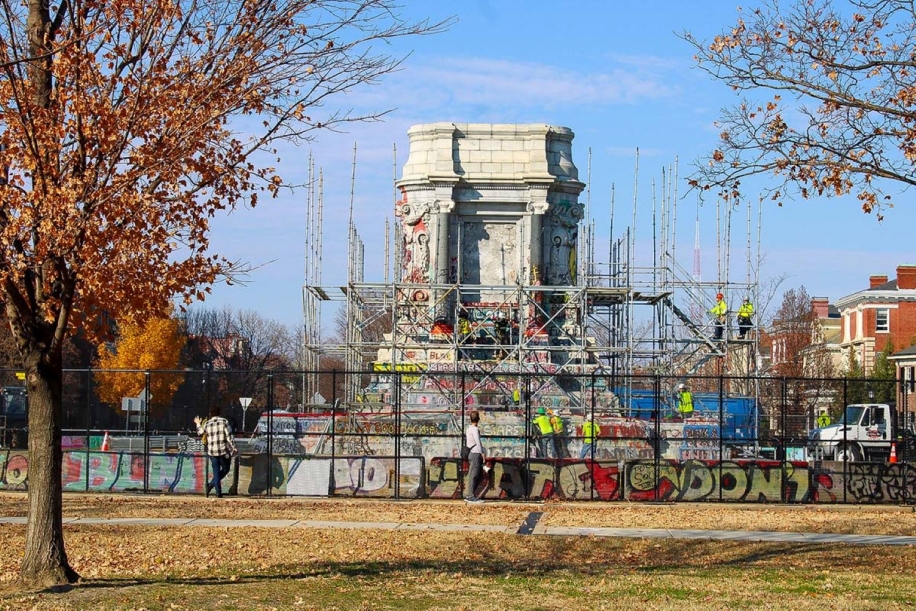
A few individuals look on as crews build scaffolding around the base of the massive pedestal that once held the Robert E. Lee Confederate statue. It took almost one month for crews, working day and night, to dismantle the empty pedestal. As they worked, they discovered 2 time capsules that had been buried over a century before. Installed in 1890, the Lee statue that sat atop the massive pedestal was removed on September 8, 2021, after months of protests and court battles. Crowds of onlookers applauded as the 12 ton, 61-foot-tall statue was lowered to the ground. The statue of Lee sitting astride his horse was so large that it had to be cut in half before it could be transported away from the site. The monument sat on a tree lined boulevard aptly named "Monument Avenue". The avenue is lined with large affluent homes and until recently, it was punctuated with 5 massive Confederate statues. After the social justice protests, the unified calls for justice and reform, and several court cases, all five of Monument Avenue’s Confederate statues, as well as other statues around the city, were removed and their pedestals were dismantled.

The Confederate statue of Ambrose Powell “A.P.” Hill stood in the middle of a busy intersection not too far from Richmond’s Monument Avenue. After the death of George Floyd, protesters in Richmond took to the streets. As they called for justice and reform, they also demanded that the city’s Confederate statues be removed. As protesters painted messages on the statues and tried to topple some of the city’s smaller statues, Mayor Levar Stoney utilized his emergency powers to remove Confederate statues from around the city including those on nearby Monument Avenue. The avenue is lined with large affluent homes and until recently, it was punctuated with massive Confederate statues. In 2020 the first statues on Monument Avenue began to come down. The A.P. Hill statue and pedestal would not be removed and dismantled for another two years. The body of Hill was buried beneath the statue. Because the area under the statue was also a burial site, the issue of moving Hill’s body delayed the statue’s removal.
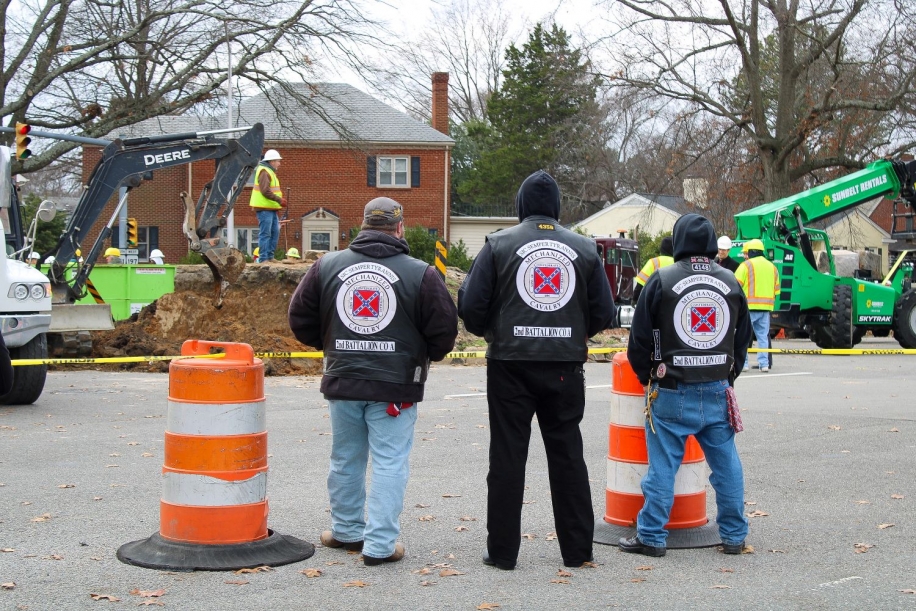
A few onlookers watch as the Confederate statue of Ambrose Powell “A.P.” Hill is removed, and workers search for his remains. After the death of George Floyd, protesters in Richmond took to the streets. As they called for justice and reform, they also demanded that the city’s Confederate statues be removed. As protesters painted messages on the statues and tried to topple some of the city’s smaller statues, Mayor Levar Stoney utilized his emergency powers to remove Confederate statues from around the city including those on nearby Monument Avenue. The avenue is lined with large affluent homes and until recently, it was punctuated with massive Confederate statues. In 2020 the first statues on Monument Avenue began to come down. The A.P. Hill statue and pedestal would not be removed and dismantled for another two years. The body of Hill was buried beneath the statue. Because the area under the statue was also a burial site, the issue of moving Hill’s body delayed the statue’s removal.